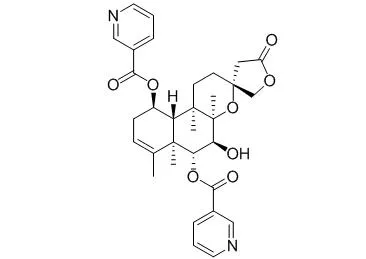| In vitro: |
| Chem Biodivers. 2017 Aug 14 | | Constituents from Scutellaria barbata Inhibiting Nitric Oxide Production in LPS-stimulated Microglial Cells.[Pubmed: 28805952] |
METHODS AND RESULTS:
The arial parts of Scutellaria barbata D. Don (Lamiaceae) efficiently inhibited NO production in BV2 microglial cells, and the active constituents were further isolated based on activity-guided isolation using silica-gel column chromatography, RP-C18 MPLC and prep-HPLC. As the results, 2 flavonoids including 6-methoxynaringenin (1) and 6-O-methylscutellarein (5), and 6 neo-clerodane diterpenes such as scutebarbatine W (2), scutebatas B (3), scutebarbatine B (4), scutebarbatine A (6), 6-O-Nicotinoylscutebarbatine G (7) and scutebarbatine X (8) were isolated. The structures of these compounds were elucidated based on NMR and MS data, and the comparison of literature values.
CONCLUSIONS:
All the compounds except compound 7 inhibited NO production efficiently with IC50 values of lower than 50 μM. Particularly, compound 1 and 8 were the most efficient with IC50 values of 25.8 and 27.4 μM, respectively. This is the first report suggesting the potential of S. barbata on the reduction of neuroinflammation. | | Natural Product Research, 2009, 11(5):451-6. | | Two new neo-clerodane diterpenoid alkaloids from Scutellaria barbata with cytotoxic activities[Reference: WebLink] |
METHODS AND RESULTS:
Two new neo-clerodane diterpenoid alkaloids, scutebarbatine O (1) and 6-O-Nicotinoylscutebarbatine G (2), were isolated from the whole plant of Scutellaria barbata. Their structures were elucidated by spectroscopic methods including extensive 1D and 2D NMR analyses.
CONCLUSIONS:
In vitro, compounds 1 and 2 showed cytotoxic activities against three human tumor cell lines, namely, HONE-1 nasopharyngeal, KB oral epidermoid carcinoma, and HT29 colorectal carcinoma cells, and with IC50 values in the range of 2.1–5.7 μM. |
|






 Cell. 2018 Jan 11;172(1-2):249-261.e12. doi: 10.1016/j.cell.2017.12.019.IF=36.216(2019)
Cell. 2018 Jan 11;172(1-2):249-261.e12. doi: 10.1016/j.cell.2017.12.019.IF=36.216(2019) Cell Metab. 2020 Mar 3;31(3):534-548.e5. doi: 10.1016/j.cmet.2020.01.002.IF=22.415(2019)
Cell Metab. 2020 Mar 3;31(3):534-548.e5. doi: 10.1016/j.cmet.2020.01.002.IF=22.415(2019) Mol Cell. 2017 Nov 16;68(4):673-685.e6. doi: 10.1016/j.molcel.2017.10.022.IF=14.548(2019)
Mol Cell. 2017 Nov 16;68(4):673-685.e6. doi: 10.1016/j.molcel.2017.10.022.IF=14.548(2019)